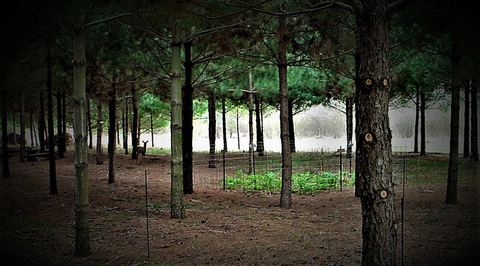Landowners, gardeners and foresters need practical solutions for protecting plants from deer. Physical barriers, hunting, and sensory and psychological deterrents can all be effective control measures.
Here are some practical tips for keeping deer away from plants.
Deer micro-exclosures
A micro-exclosure is a small, fenced compound for deer control based on the concept that deer avoid entering small spaces. Micro-exclosures provide a psychological deterrent to deer, appearing too risky for fast entry and exit.
With support from the Central RSDP, Wadena farmer and private forest owner Kent Scheer conducted trials on six micro-exclosures. Scheer built exclosures using cattle panels.
Micro-exclosures can be used to protect plants in home vegetable gardens and reforestation projects. They work well for defining nursery beds, fencing berry plantings, protecting rare wildflowers, securing high-value plants such as ginseng, and supporting increased woodland diversity. Micro-exclosures can also be used in landscaping, providing simple, clean framing for a prized collection of hostas or lilies.
During two growing seasons (100 days), Scheer experienced only one breach in his pilot micro-exclosures. This was solved by reducing the size of the micro-exclosure. Once the area was made smaller, no further breaches occurred.
Constructing an exclosure
Micro-exclosures can be built using cattle panels commonly available at farming supply stores. The panels come in 16-foot lengths. They are rigid and self-supporting but can be bowed to fit into the bed of a standard pick-up truck for transporting.
Exclosures can be made of four cattle panels connected at the corners with cable clamps to form a 16-foot square. Other shapes and configurations can also be formed with fewer or more panels.
The top wire across the exclosures measures 50 inches from the ground. Three of the four corners are secured by cable clamps, and the remaining corner is left unconnected to serve as a gate. A total of nine 3/8-inch cable clamps are needed, with three in each of the three corners.
Scheer recommends using four six-foot steel T posts with one wired to the center of each panel for increased rigidity.
Scheer built an entire micro-exclosure for about $150 in 2018, with materials estimated to last at least 10 years. In his experience, micro-exclosures are easy to move around.
Success rate
Micro-exclosures have shown a high success rate, but they should be monitored. Deer demonstrate regional differences in behavior, so it is important to observe whether the exclosure is effectively serving as a psychological deterrent.
If a breach occurs, the exclosure can be made to appear smaller by installing a fifth cattle panel in the center or by stretching a wire hung with flagging across the midsection.
The Minnesota Department of Natural Resources offers design and assistance for business-scale deer exclosures.
DIY deer repellent
Repellents are another popular option for deer control. Commercial sprays can be effective when used according to directions, and a University of Minnesota research project identified a do-it-yourself solution.
A 1994 study compared deer response to a variety of commercial repellents, methods of application, and levels of concentration. The study also included a simple home solution of eggs and water. The study found the home solution (a recipe of 3 chicken eggs per 3.78 L of water) to be the most effective repellent. Variations of this simple solution have since become a part of gardening folklore.
- Use a blender to blend three whole eggs thoroughly in water.
- Pour the mixture into a container and add water to reach one gallon. Strain.
- Spray the mixture onto new growth with thorough coverage using a hand sprayer or tank sprayer for larger amounts. Spray until leaves are wet and have a sheen.
- Reapply every two weeks or after rain.
The DIY egg spray offers a lower-cost alternative to commercial sprays and is a reliable deer repellent for summer months when applied diligently.
A variety of online recipe variations of this basic formula can be found. But gardening folklore is not always tested. The same University of Minnesota research demonstrated that adding secondary ingredients may mask the egg odor enough to reduce the spray's effectiveness.
When using DIY deer repellent, it’s important to be aware of its limitations and to understand deer psychology. Important considerations include:
- The repellent needs to be reapplied every two weeks or after a heavy rain.
- Desperate conditions or exceptionally heavy deer pressure may lead deer to override their aversion.
- Because the repellent works through deer’s sense of smell, the solution is not effective over winter and you will need an alternative.
- After extended use, deer may grow accustomed to the solution. To avoid this, you can occasionally shift to a different odor-based formula or a formula with a hot pepper active ingredient.
- If the egg mixture is allowed to sit for more than a day, it develops an unpleasant odor. The longer it sits, the stronger the odor becomes. For this reason, it is best to avoid application on food before harvest.
- At its richest, it can take a good scrubbing to remove the solution from hands and a warm wash to remove it from clothes. You may want to avoid spraying it near the house or in the yard before company arrives.
Even with these exceptions, this simple home remedy is estimated to cover 75% or more of average deer repellent needs at minimal cost. There may be commercial formulas that can protect longer, but the simple DIY recipe can be an excellent substitution if you run out, are not prepared at the beginning of the season, or want to save money.
Lutz, J. A. (1996). Comparative effectiveness of repellents for reducing deer feeding damage to woody and herbaceous plants in Minnesota. University of Minnesota. Master's thesis.
Lutz, J. A., and Swanson, B. T. (1995). Reducing deer damage to woody and herbaceous plants. Repellents in Wildlife Management Symposium, DigitalCommons@University of Nebraska - Lincoln, pp. 231–40.
Mohr, C., and LaMond, A. (2018). Protecting our gardens from deer. RSDP Happenings. University of Minnesota Extension Regional Sustainable Development Partnerships.
Otten, J. (2018). A review of deer fencing and repellents for home gardens. Unpublished research conducted for a project of the University of Minnesota Extension Central Regional Sustainable Development Partnership.
Scheer, K. (2018). Summary evaluation of the three deer control systems. Unpublished research conducted for a project of the University of Minnesota Extension Central Regional Sustainable Development Partnership.
Reviewed in 2023





